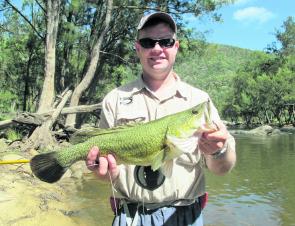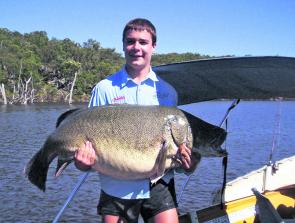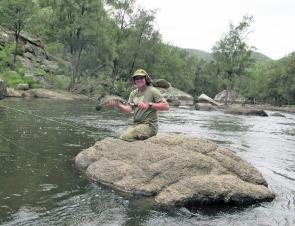As the New England weather continues to cool the local angling action tapers off. While most native species become a little less active, the final month of the trout season gets hot.
All the regional trout streams will be full of fit fish ready to tangle with a well-placed streamer fly or minnow lure. The key to fish this time of year for local trout is to work the larger pools aggressively.
Most trout, especially larger specimens, will be patrolling the pools and seeking to build condition for spawning. While it is the subject of many discussions how successfully New England trout breed, they certainly go through the motions.
Fly flickers will do well to concentrate on streamer patterns throughout the day. Matukas and Woolly Buggers tend to cover most situations.
Matuka patterns from size 10 to 4 are terrific in the shallower holes.
Where the water deepens and along the drop-offs at the pool heads, try a weighted Bugger in similar sizes but with a dash of colour. I tie my late season Buggers with a simple marabou tail and body of pink or red Estaz Chenille; don’t worry about palmered hackles.
Fish the flies with a fairly aggressive retrieve and expect solid strikes. During the mid season I often shorten the tails on my streamers because hits tend to be a little tentative. But from now until the season closes you’ll be in no doubt whether it was a strike.
Similar rules apply to lure angling. In the deeper pockets fish a bright minnow pattern that has a tight action. The crawdad style patterns are perennial favourites, as are the Rapala minnows.
Soft plastics can produce but go for light jig heads and give the lure more action than the traditional hop and stop.
The native fish action will begin to slow down now. Most keen bass chasers are done for the year although you will still stir the odd fish or two, particularly when the sun is high. Tactics don’t really change here from the hot Summer bite.
Work the shadows and snags throughout the day with medium divers and smaller spinnerbaits. Don’t be surprised if the night surface sessions still produce, though generally things will be quiet.
Even so, this is a sensational time to hit the gorges with cold nights but clear days. The lyrebirds and dingoes will be starting to make a little more noise so get out around the fire before the really cold conditions hit.
I recently had a quick trip down the gorge country chasing some cod with John Everett. It was a flying visit but, as always, the gorge produced the goods.
It was a fly only trip and in the 24 hours we landed about 25 small to medium fish. I have to say Johnny and his ‘Cat’s Balls’ fly kicked my butt in terms of fish banked but it really was a terrific outing.
The trip reinforced several things when chasing fish in the rough stuff. These simple rules apply even more when fish are unresponsive and tucked into the structure.
• Practise, practise and practise: Fishing in the snags is a whole different ball game to pelting lures on open water. Before a trip into the tight stuff spend an afternoon or two flicking your weapon of choice in the backyard. Set up a target and work at it.
• Check your gear. On my recent trip I discovered too late that the marabou tails on some of my flies had suffered from not being totally dry when packed away. Three hours’ walk from the truck is not the time to discover your flies, lures and leaders are not in top condition.
• Fish hard. I guess I was ready for a lazy trip and didn’t really put in as much effort as my companion in getting out and targeting the hard-to-get-to snags. I certainly didn’t lose any sleep over it but John put in the extra yards and it showed in the numbers and quality of fish he banked.
The coming month is going to be a little tough for all but the trout brigade. That said, I still think that working the water hard will bring fish, the key is perseverance and going the extra kilometre.
Forget the early starts and focus on shallower water which will hold the fish.
For cod and yellowbelly action I’d be heading straight to any of the impoundments. Troll or cast medium-sized, wide-action lures into the structure. This is where suspending lures allow you to work the lure longer in the strike zone.
Retrofitting lures with single hooks can reduce snagging and if you know a fly tier, get them to show you how to tie weed guards.
Copeton Dam in particular has developed a reputation for fishing well throughout the cold months. With the excellent water levels, expect to find fish anywhere but tweaking lures through the standing timber is worth exploring.
While the western shore offers plenty of camping and easy access, the eastern side has some excellent water for those willing to walk. Here access is relatively easy via Bundarra and you’ll find conditions a little more primitive.
Either way, I’d give Copeton a shake-up this month.
Split Rock and Chaffey dams are probably best targeted from a boat with some great trolling runs near the dam wall or further up the top end.
Keepit Dam has plenty of options and, like Copeton, it just depends on what you’re looking for.
This month I’d be walking the shoreline below the ski gardens looking for steep shingle banks and hopping large soft plastics up the face.
Get out and get into it before the frosts turn nasty. I hate fishing when the rod guides are iced up!
Reads: 2718
John Everett with a neat gorge cod. This fish hit a large streamer fly right in front of camp.

Eathan Callies with a thumping 123cm cod from Copeton. This fish belted a 75mm Oar-Gee Plow, one of New England’s go-to cod lures.

The author in the middle of nowhere. New England is blessed with the most pristine angling venues.




